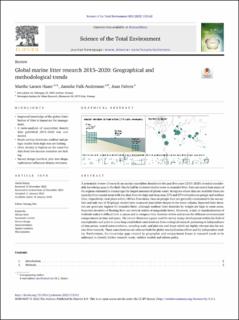| dc.contributor.author | Haarr, Marthe Larsen | |
| dc.contributor.author | Falk-Andersson, Jannike | |
| dc.contributor.author | Fabres, Joan | |
| dc.date.accessioned | 2022-03-17T12:37:26Z | |
| dc.date.available | 2022-03-17T12:37:26Z | |
| dc.date.issued | 2022 | |
| dc.identifier.citation | Science of the Total Environment. 2022, 820, 153162. | en_US |
| dc.identifier.issn | 0048-9697 | |
| dc.identifier.uri | https://hdl.handle.net/11250/2985856 | |
| dc.description.abstract | A systematic review of research on marine macrolitter densities in the past five years (2015–2020) revealed considerable knowledge gaps in the field. Nearly half he reviewed studies were on stranded litter. Data are scarce from many of the regions estimated to mismanage the largest amounts of plastic waste. In regions where data are available these are typically from coastal areas with few data from the high and deep seas; 57% and 87% of studies on pelagic and seafloor litter, respectively, took place within 100 km from shore. Data on pelagic litter are generally constrained to the sea surface and only two of 30 pelagic studies have measured macrolitter deeper in the water column. Reported litter densities are generally highest for stranded litter, although seafloor litter densities by weight are high in some areas. Reported densities of floating litter are several orders of magnitude lower. However, a lack of standardisation of methods makes it difficult both to assess and to compare litter densities within and across the different environmental compartments in time and space. The review illustrates a great need for survey design development within the field of macroplastics and point to some long-established considerations from ecological research pertaining to independence of data points, spatial autocorrelation, sampling scale, and plot size and shape which are highly relevant also for marine litter research. These considerations are relevant both for global standardisation efforts and for independent studies. Furthermore, the knowledge gaps created by geographic and compartment biases in research needs to be addressed to identify further research needs, validate models and inform policy. | en_US |
| dc.language.iso | eng | en_US |
| dc.publisher | Elsevier | en_US |
| dc.rights | Navngivelse 4.0 Internasjonal | * |
| dc.rights.uri | http://creativecommons.org/licenses/by/4.0/deed.no | * |
| dc.title | Global marine litter research 2015–2020: Geographical and methodological trends | en_US |
| dc.type | Peer reviewed | en_US |
| dc.type | Journal article | en_US |
| dc.description.version | publishedVersion | en_US |
| dc.rights.holder | © 2022 The Authors | en_US |
| dc.source.volume | 820 | en_US |
| dc.source.journal | Science of the Total Environment | en_US |
| dc.identifier.doi | 10.1016/j.scitotenv.2022.153162 | |
| dc.identifier.cristin | 1990153 | |
| dc.source.articlenumber | 153162 | en_US |

